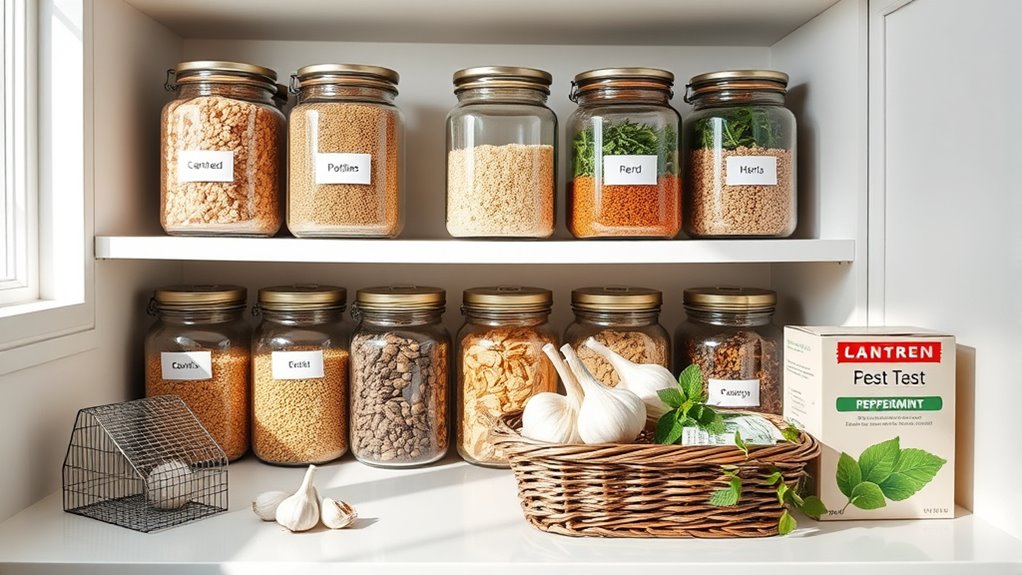Implementing routine preventative tasks is key to keeping pests and problems at bay. Regular inspections help you spot early signs of infestation, while sealing entry points and maintaining good sanitation reduce attractants. Seasonal measures like trimming vegetation and removing standing water further prevent pests from establishing themselves. Consistent upkeep not only protects your health and property but also saves you money on expensive treatments later. Keep going to discover more simple strategies that can make a big difference.
Key Takeaways
- Conduct regular home inspections to identify and seal potential pest entry points early.
- Maintain cleanliness by promptly removing food debris, trash, and standing water that attract pests.
- Trim vegetation and keep outdoor areas tidy to eliminate pest habitats near your home.
- Seal cracks, gaps, and openings in walls, doors, and windows to prevent pest access.
- Implement seasonal routines like gutter cleaning and moisture control to reduce pest breeding sites.

Have you ever wondered how much you can save—both in health and money—by taking proactive steps? When it comes to pest control, early detection is your best friend. Spotting signs of pests early allows you to address issues before they become costly or hazardous. The benefits of early detection extend beyond just avoiding expensive exterminations; they also protect your health. Pests like rodents, cockroaches, and ants can carry diseases, contaminate food, and trigger allergies. Catching an infestation early means you can implement targeted solutions quickly, minimizing health risks and reducing the need for harsh chemicals. This proactive approach not only keeps your home safer but also saves you money in the long run by preventing extensive damage and complicated treatments. Regular home maintenance and inspections are essential components of effective pest prevention strategies. Seasonal pest prevention is another vital aspect of preventative care. Pests tend to be more active during certain times of the year—spring and summer are prime seasons for ants, mosquitoes, and wasps, while rodents often seek shelter indoors as temperatures drop. Preparing your home ahead of time with seasonal pest prevention measures helps you stay one step ahead. Simple tasks like sealing cracks and gaps around windows and doors, removing standing water, and trimming back overgrown vegetation can make a significant difference. These actions deny pests easy entry points and breeding grounds, reducing the likelihood of infestations. Being aware of pest activity trends can help you target your prevention efforts more effectively. Establishing a preventative care routine is essential for maintaining ongoing pest resistance. By establishing a seasonal pest prevention routine, you guarantee your home remains unappealing to pests throughout the year, saving you the hassle and expense of dealing with full-blown invasions later. Regular inspections and proper home maintenance are vital for effective preventative care. Preventative care isn’t just about reacting to problems—it’s about creating a barrier to keep them from ever starting. Home cleanliness and maintaining the integrity of your property are small tasks that pay off big time. Additionally, understanding pest behavior can help you anticipate and prevent infestations more effectively. Incorporating proper sanitation practices can further reduce attractants and make your home less inviting to pests. When you stay vigilant and proactive, you reduce the chances of pests establishing themselves, which means fewer emergencies and less need for aggressive treatments. This approach also prolongs the lifespan of your property and belongings, as pests can cause significant damage if left unchecked. Plus, it gives you peace of mind, knowing you’re actively protecting your home, your health, and your wallet. So, make preventative care a habit—your future self will thank you for the effort. Staying ahead with early detection and seasonal pest prevention is the smartest way to keep problems at bay and enjoy a healthier, pest-free home.
Frequently Asked Questions
How Often Should I Schedule Professional Pest Inspections?
You should schedule professional pest inspections based on your inspection frequency needs, typically every 3 to 6 months. Seasonal scheduling is key, as pests tend to be more active during certain times of the year. Regular inspections help catch problems early and prevent infestations. Talk to your pest control provider to determine the best inspection schedule for your home, ensuring ongoing protection year-round.
Are Natural Remedies Effective for Pest Prevention?
Did you know 60% of homeowners prefer natural pest prevention methods? You might find herbal repellents and organic traps effective, as they can deter pests without harmful chemicals. While not foolproof, many people see good results by combining these remedies with good sanitation. Natural remedies can be a part of your overall pest prevention plan, offering a safer, eco-friendly way to keep unwanted visitors at bay.
What Signs Indicate a Pest Infestation Before It Becomes Severe?
You should look for signs of infestation like droppings, gnawed wires, or damage to your belongings. Early pest indicators include strange odors, nests, or sightings of pests themselves. If you notice these early pest indicators, act quickly to prevent the problem from escalating. Regular inspections help catch signs of infestation early, allowing you to take prompt action and keep pests from becoming a severe issue.
How Can I Prevent Pests in New Construction Homes?
To stay ahead of pests in new constructions, don’t put all your eggs in one basket. Use construction barriers to block entry points and opt for pest-resistant materials during building. Regular inspections and sealing gaps keep pests at bay. By taking these proactive steps, you’re building a fortress that pests can’t breach, saving you trouble down the line and ensuring a pest-free home from day one.
Does Landscaping Impact Pest Prevention Strategies?
Landscaping design plays a vital role in pest prevention because it directly impacts pest habitat. By keeping bushes and trees trimmed away from your home, you reduce hiding spots for pests. Removing debris and standing water also discourages breeding grounds. Thoughtful landscaping creates a barrier, making it harder for pests to access your home, and ultimately, helps you maintain a pest-free environment more effectively.
Conclusion
By staying proactive with routine tasks like sealing cracks and keeping your space clean, you can prevent pests from taking hold. Imagine a homeowner who regularly inspects and maintains their property—when a tiny crack appeared, they sealed it immediately, avoiding a full-blown infestation. Small, consistent actions save you time and money in the long run. Don’t wait for problems to grow; take preventative steps today and keep your home pest-free effortlessly.









